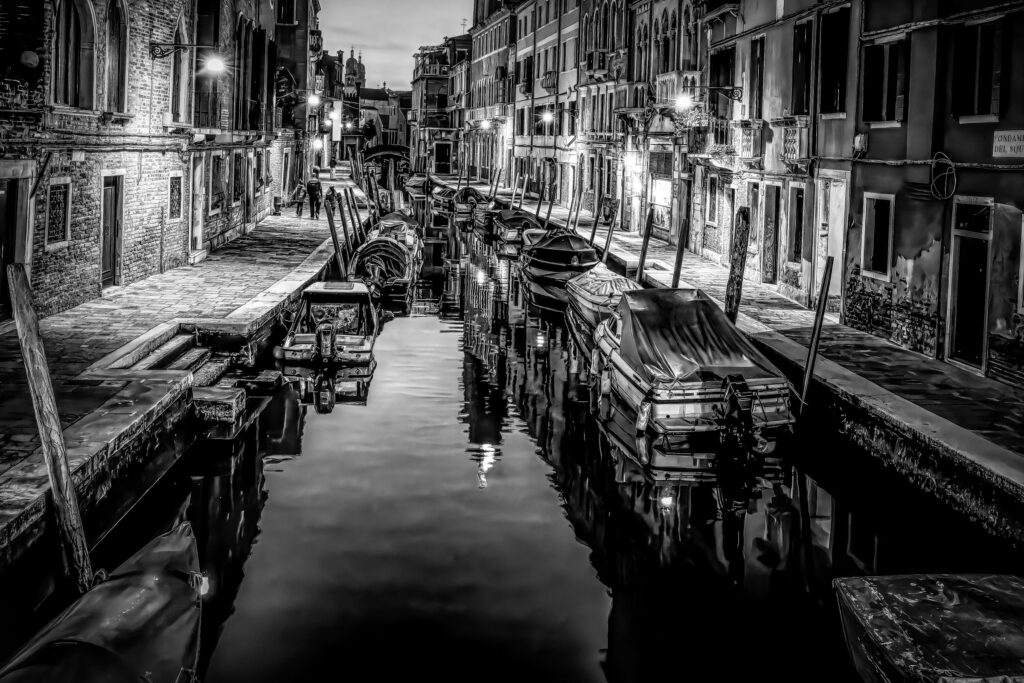Venice After Dark: A Black and White Nocturne That Stops Time
When exhaustion meets magic in the silent canals of Venice – the story behind a unique 1/1 photograph
February in Venice. The air hangs humid but not particularly cold. After a full day of chasing light through the labyrinthine streets, when Sister Sun finally retreats beyond the horizon, something extraordinary happens. The city transforms. The tourists vanish. The gondoliers rest. And Venice begins to breathe its ancient breath.
This is the story of a photograph that almost didn’t happen – captured at that precise moment when exhaustion meets magic, when a photographer’s depleted body encounters a scene too perfect to ignore.
The Moment When Venice Shows Its True Face
Venice has this peculiar effect on photographers: it drags you along its stone arteries, and you don’t feel the fatigue until it’s almost too late. You suspend your vital functions, becoming stupefied by exhaustion, yet unable to stop capturing the magic unfolding before your lens.
That February evening, I was devastated. My body screamed for rest, my mind foggy from hours of shooting. The car was still far away, the path ahead tortuous through Venice’s maze-like streets. Then I turned a corner, and there it was – a scene straight from a Dashiell Hammett novel, noir and ethereal simultaneously.
The canal stretched before me like a liquid mirror, its surface so still it seemed to hold its breath. The lamplight – those iconic Venetian street lamps that replaced the gas lights of the 19th century – cast golden pools on the water, creating a theatrical atmosphere that black and white photography was born to capture.
The Hidden Venice: What This Photograph Reveals
This isn’t the Venice of postcards. This is one of the city’s 150 minor canals – the rii – where real Venetian life unfolds. Here, boats covered with tarps serve as the “parked cars” of residents. Some are small fishing boats, others motorboats for daily commutes or cargo transport. Venice even has fire department boats, ambulance boats, and water taxis navigating these narrow waterways.
The buildings you see have stood here for centuries, their foundations submerged in water, their ground floors once designed to receive noble guests arriving by gondola. The fondamenta – the walkway along the canal – is paved with masegni, massive trachyte slabs from the Euganean Hills near Padua, worn smooth by centuries of footsteps and high tides.
Look closely at the upper right of the photograph, and you might glimpse one of Venice’s stone street signs, many dating back to the 18th century. These nizioleti (little sheets) in white Istrian stone mark the intricate toponymy of Venice: calle (street), campo (square), fondamenta (canal-side walkway).
Capturing Venice in Monochrome
When daylight fades, Venice reveals its architectural bones. The absence of color strips away the tourist veneer, leaving only form, texture, and the interplay of light and shadow. The longer exposure times necessary for night photography allow the water to become glass-like, creating perfect reflections that double the visual impact of every illuminated window and lamppost.
This particular photograph was captured at 5460×3640 resolution, ensuring every detail – from the weathered brick to the gentle ripples where boats kiss the water – remains crystal clear even at large print sizes. The black and white treatment emphasizes the timeless quality of the scene, connecting this moment in 2025 to centuries of Venetian nights.
Venice Noir: From Literature to Cinema
In black and white, Venice becomes a film set. It’s no coincidence that directors have chosen these lesser-known canals to evoke mystery and romance – from David Lean’s “Summertime” (1955) to Nicolas Roeg’s haunting “Don’t Look Now” (1973). The interplay of light and shadow, the reflections doubling reality, the sense of being watched from darkened windows – all contribute to an atmosphere that’s simultaneously romantic and slightly sinister.
At night, Venice changes its voice. The day’s cacophony of tourist chatter gives way to solitary footsteps echoing off stone walls, water gently lapping against boat hulls, and if you’re fortunate, the distant song of a gondolier or the bronze voice of a church bell marking the hours.
Own This Unique Piece of Venice
Edition: 1/1 (Single Edition – This is the only one)
Resolution: 5460×3640 pixels (print-ready at any size)
Price: 69 XTZ
Rights: Full commercial usage included (royalty-free)
Usage: Campaigns, branding, publications, personal collection
Platform: OBJKT on Tezos blockchain
When Exhaustion Creates Art
Sometimes the best photographs come when we’re too tired to overthink, when our defenses are down and we’re operating on pure instinct. This image exists because exhaustion met opportunity on a humid February night in Venice, because sometimes you have to stop even when your body begs you to continue walking.
Venice at night strips away pretense. No crowds to navigate, no perfect light to chase – just you, the ancient stones, and the quiet poetry of water meeting architecture. This photograph captures that liminal moment when the city belongs not to tourists or merchants, but to shadows and reflections, to the ghosts of centuries and the whisper of water against stone.
This unique 1/1 edition represents not just a photograph, but a moment that will never repeat – a February night in Venice when exhaustion became inspiration, when noir met ethereal, when a photographer almost walked past but couldn’t.
